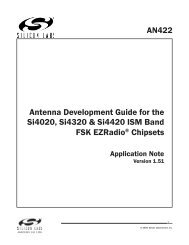C8051F326/7 - Silicon Labs
C8051F326/7 - Silicon Labs
C8051F326/7 - Silicon Labs
You also want an ePaper? Increase the reach of your titles
YUMPU automatically turns print PDFs into web optimized ePapers that Google loves.
<strong>C8051F326</strong>/7<br />
12.13. Controlling Endpoint1 OUT<br />
Endpoint1 OUT is managed via USB registers EOUTCSRL and EOUTCSRH. It can be used for Interrupt,<br />
Bulk, or Isochronous transfers. Isochronous (ISO) mode is enabled by writing ‘1’ to the ISO bit in register<br />
EOUTCSRH. Bulk and Interrupt transfers are handled identically by hardware.<br />
An Endpoint1 OUT interrupt may be generated by the following:<br />
1. Hardware sets the OPRDY bit (EINCSRL.0) to ‘1’.<br />
2. Hardware generates a STALL condition.<br />
12.13.1.Endpoint1 OUT Interrupt or Bulk Mode<br />
When the ISO bit (EOUTCSRH.6) is logic 0, Endpoint1 operates in Bulk or Interrupt mode. Once it has<br />
been configured to operate in Bulk/Interrupt OUT mode (typically following an Endpoint0<br />
SET_INTERFACE command), hardware will set the OPRDY bit (EOUTCSRL.0) to ‘1’ and generate an<br />
interrupt upon reception of an OUT token and data packet. The number of bytes in the current OUT data<br />
packet (the packet ready to be unloaded from the FIFO) is given in the EOUTCNTH and EOUTCNTL registers.<br />
In response to this interrupt, firmware should unload the data packet from the OUT FIFO and reset<br />
the OPRDY bit to ‘0’.<br />
A Bulk or Interrupt pipe can be shut down (or Halted) by writing ‘1’ to the SDSTL bit (EOUTCSRL.5). While<br />
SDSTL = ‘1’, hardware will respond to all OUT requests with a STALL condition. Each time hardware generates<br />
a STALL condition, an interrupt will be generated and the STSTL bit (EOUTCSRL.6) set to ‘1’. The<br />
STSTL bit must be reset to ‘0’ by firmware.<br />
Hardware will automatically set OPRDY when a packet is ready in the OUT FIFO. Note that if double buffering<br />
is enabled for Endpoint1, it is possible for two packets to be ready in the OUT FIFO at a time. In this<br />
case, hardware will set OPRDY to ‘1’ immediately after firmware unloads the first packet and resets<br />
OPRDY to ‘0’. A second interrupt will be generated in this case.<br />
12.13.2.Endpoint1 OUT Isochronous Mode<br />
When the ISO bit (EOUTCSRH.6) is set to ‘1’, Endpoint1 operates in Isochronous (ISO) mode. Once it has<br />
been configured for ISO OUT mode, the host will send exactly one data per USB frame; the location of the<br />
data packet within each frame may vary, however. Because of this, it is recommended that double buffering<br />
be enabled when Endpoint1 is used in Isochronous mode.<br />
Each time a data packet is received, hardware will load the received data packet into the endpoint FIFO,<br />
set the OPRDY bit (EOUTCSRL.0) to ‘1’, and generate an interrupt (if enabled). Firmware would typically<br />
use this interrupt to unload the data packet from the endpoint FIFO and reset the OPRDY bit to ‘0’.<br />
If a data packet is received when there is no room in the endpoint FIFO, an interrupt will be generated and<br />
the OVRUN bit (EOUTCSRL.2) set to ‘1’. If USB0 receives an ISO data packet with a CRC error, the data<br />
packet will be loaded into the endpoint FIFO, OPRDY will be set to ‘1’, an interrupt (if enabled) will be generated,<br />
and the DATAERR bit (EOUTCSRL.3) will be set to ‘1’. Software should check the DATAERR bit<br />
each time a data packet is unloaded from an ISO OUT endpoint FIFO.<br />
112 Rev. 1.1


